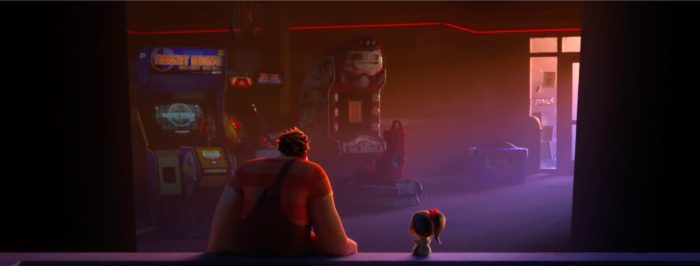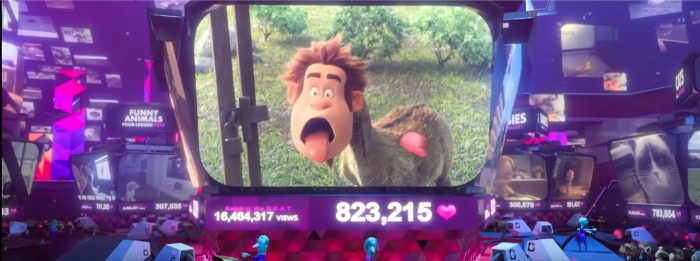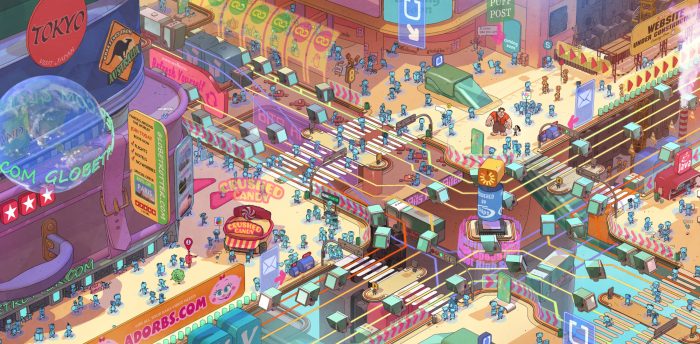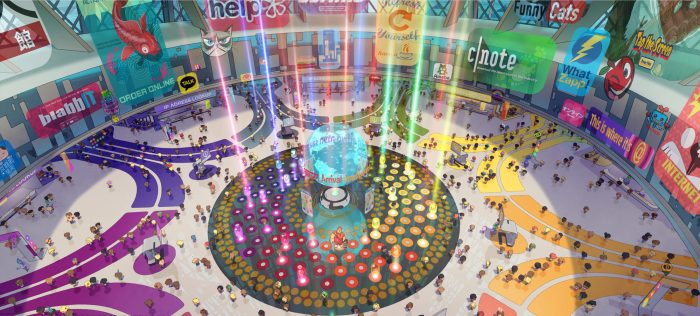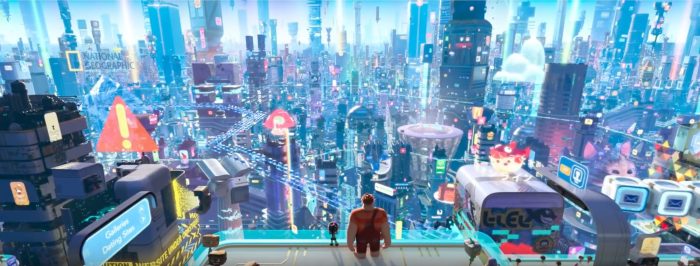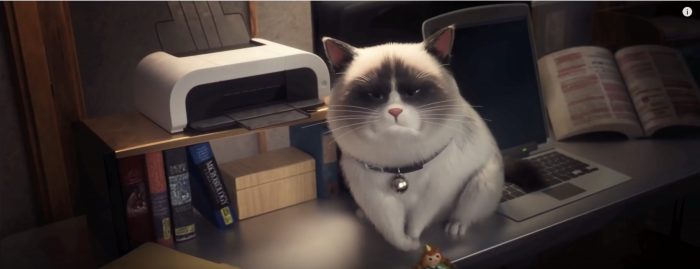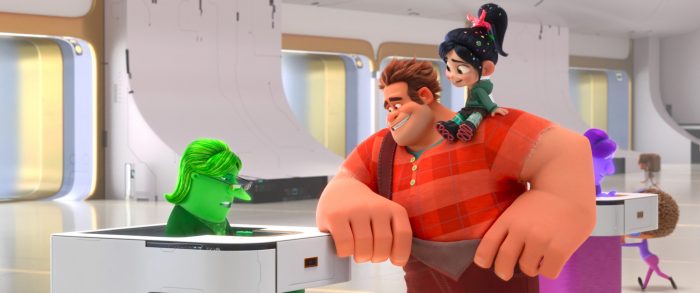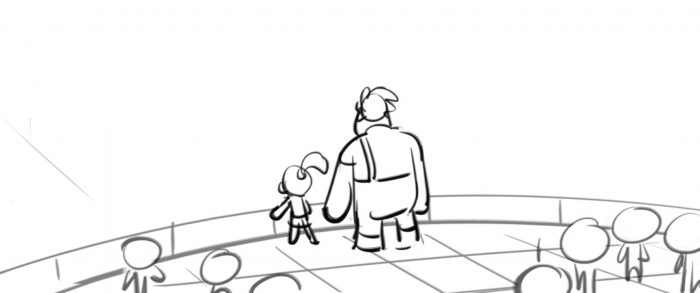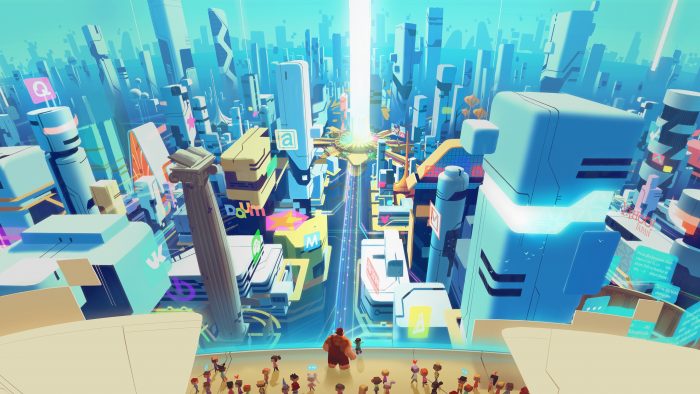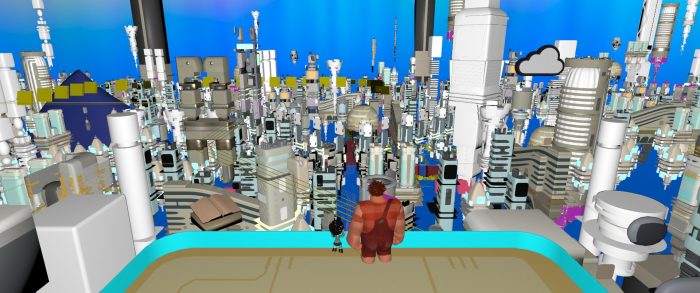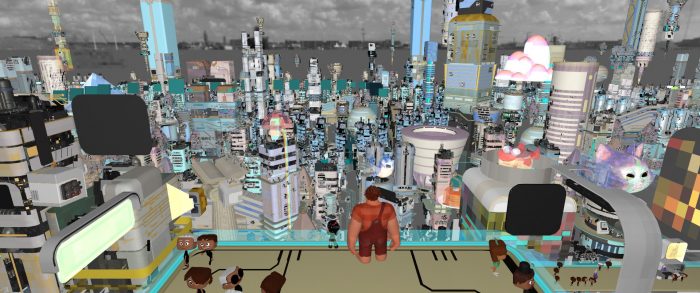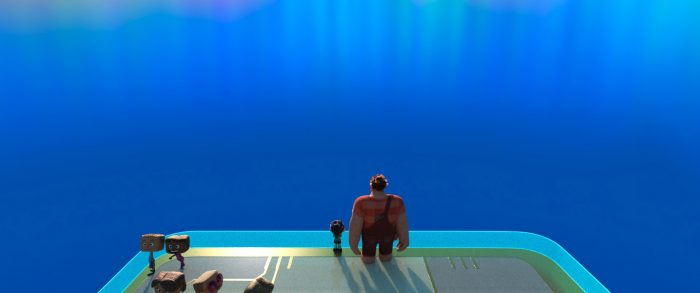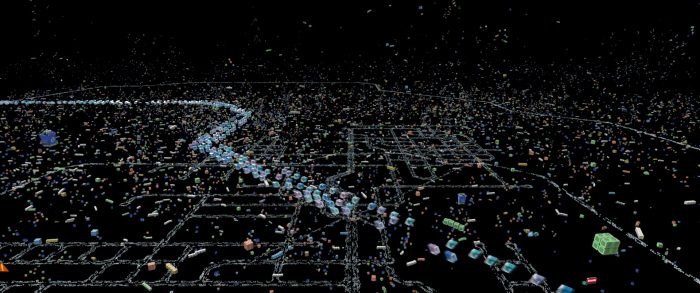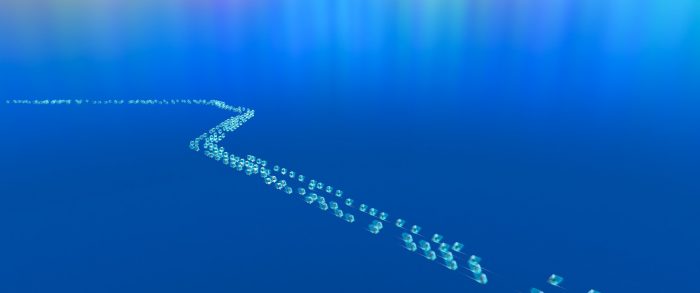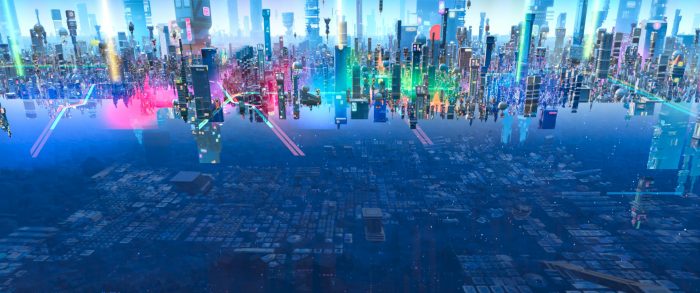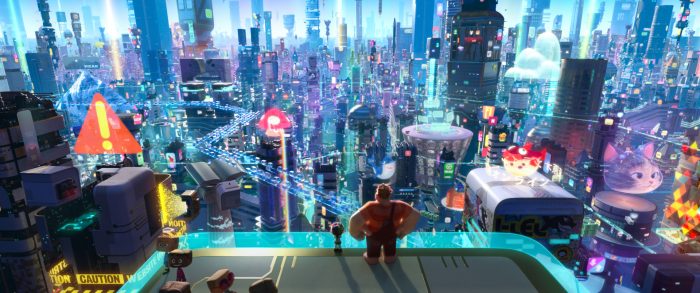How 'Ralph Breaks The Internet' Transforms The World Wide Web Into A Fully-Realized World
Ralph Breaks the Internet takes John C. Reilly's good-natured video game "bad guy" out of the arcade and drops him into the world wide web. But the filmmakers and animators and designers at Disney Animation faced a challenge: how do you transform the internet into an actual place that can be occupied by characters? How can something abstract become the setting of an animated movie?
Here's how the production found the story for Ralph Breaks the Internet and built this in-depth new world around it, a process that nearly broke render computers and went through numerous iterations.
The Story So Far
Before we talk about the design of the world of Ralph Breaks The Internet, we need to give you the basic set-up of the story. It starts where things left off in Wreck-It Ralph. Vanellope and Ralph have remained friends, spending time together outside of their games when the arcade is closed. One day, their after-hours ritual is interrupted by a plugin alert: something new has been installed in Mr. Litwak's Family Fun Center & Arcade – something called WiFi.
The next day, a kid playing the Sugar Rush game ends up breaking the steering wheel off the arcade console. The game has long been discontinued, and the manufacturer is out of business. The kids find a replacement part on eBay, but even with the increased popularity of Sugar Rush, the price is more than the game makes in a year. So Mr. Litwak decides to pull the plug on the game, which leaves Vanellope homeless.
Ralph offers Vanellope a place to stay inside the Fix-It Felix game, building her a pillow fort on top of his building. She's devastated that her game is gone forever. If she's not a racer, what is she? She begins glitching and decides she needs to be alone and storms off. Ralph gets an idea to sneak into the internet router in the arcade to get to eBay to obtain the replacement part.
Ralph and Vanellope travel to the router for the first time. It turns out to be an unremarkable box, which Ralph remarks is not as impressive as it was described. The movie cuts to inside Litwak's small office in the arcade, with him figuring out how to turn the router on using his old iMac. As he presses the button, the router box transforms into a green high tech room like something out of Tron. Litwak's avatar appears in front of them inside the router and walks into a portal, and they follow him through the tunnel, shooting through the cord, into the telephone wires, eventually into the internet itself – a huge digital city. They end up in something that looks like a huge airport terminal.
The search bar Knowsmore sends them on a journey to eBay, a cavernous building filled with rows and rows of auctioneers, where there are tons of cubicles, each with their own auctioneer and Net Users watching. Among the items we see on auction include a Dorito chip with the face of Beyonce and a velvet painting of a kitten. Each row in the eBay headquarters has a sign, with the whole building organized by section, almost like a supermarket. They go to the video games aisle and start bidding on the steering wheel. Vanellope bids $1000 and Ralph starts bidding against her, clearly not smart enough to understand the concept of an auction. The steering wheel ends up selling for $27,001, and they get a voucher to bring to checkout for processing.
At the checkout counter, they are asked for a credit card, which they clearly don't have. So Ralph starts making up numbers. The "Netizen" at the register realizes that they don't have payment and tells them that they have 24 hours to pay before they forfeit the item.
How are two video game characters from a small arcade going to earn the money? They meet a character named Yesss at BuzzTube who has an idea. With only eight hours left before they need to pay the eBay bill, Yesss sends Vanellope to a fan site to market the viral videos she and Ralph created. The place she is sent is a fan site called OhMyDisney.com, which is described as everything Disney all under one roof. It is here that she somehow ends up in a dressing room with all of the Disney princesses, a scene that has been shown off at conventions and in the trailers.
The Earlier Versions of the Story
The treatment for this film began in 2014. The earliest version of the script had Vanellope getting sucked up into the internet – she had her own website called Vanellope.com, and she was giving a TED Talk, and the character changed. Ralph mistook going "viral" for being a virus, and internet security locked him up in jail. He broke out of jail with Knowsmore, who was a much more prominent character in that early version of the story – he was a broken search engine. And Ralph and Knowsmore were partnered up in a search for Vanellope, who was changing dramatically, going from the Vanellope we know to a dolled-up internet celebrity who forgot who she was.
A later version of the script flipped that idea, with Ralph becoming enamored with himself, drunk on his own fame and popularity. For some of those early versions of the story, there was a villain character, an internet supercop named Bev, which was like McAfee or Norton Antivirus. However, the story team eventually came to the realization that this is the story of the two of them, Ralph and Vanellope, who go to a big city. One loves it, the other doesn't care for it, and they realize they have two very different journeys ahead that will test their friendship. This is the version that became the movie.
Developing the World of the Internet
Filmmakers Rich Moore and Phil Johnston say the reason they found to do a Wreck-It Ralph sequel was the comedy and conflict that comes from transporting our main characters from the small town of the arcade into to the virtual city of the internet.
The big challenge in developing this movie was to design an animated version of the internet that felt like the internet we use every day. On Zootopia, Moore and Johnston took their development team to Africa, on Moana they went to the South Pacific, and for Ralph Breaks the Internet, they took a luxurious research trip down the street to One Wilshire Blvd, a 30 story building in downtown Los Angeles which houses most of the internet connections in the western U.S. One-third of internet traffic from the U.S. to Asia passes through the structure.
As you might expect, the facility is filled with wires and boxes from top to bottom, which they used as inspiration for their virtual internet city. In the earliest animation tests, the internet city featured streets that look like the wired lanes in the building. They also photographed panels on computer motherboards and chips to help inspire the internet world's city grid.
The Internet is a three-dimensional vertical city, which means it functions on a different level than our real-world cities. For example, there are sidewalks on different levels and different ways into every building, envisioned like there are different ways into every website. The design language uses the 45-degree angles that you would see on a motherboard. The filmmakers populated the street with signage and holograms to add charm and color. There are other small touches, too: if you enter a travel website building, you are handed free cookies.
The Internet Hub
Ralph and Vanellope arrive in the internet via a place called the Internet Hub (pictured above in concept art), which is designed to look like one of those huge futuristic international airport terminals. In the real world, if you wanted to send a lot of data through fiber optics, you would break down the data into different colors. This was the inspiration for the color guided systems that you see the characters land on in this scene. The platform itself is inspired by the undersea cables that connect the internet between continents.
The World of the Internet Broke Disney's Render Computer
To create a never-ending metropolis, the team created a bunch of buildings that could be styled modularly in different variants, so when you look out into the horizon, it doesn't look like there is an end or repeat in structures. This was very resource-intensive, as you might imagine. The first time they tried to render the city with their Hyperion render facility, it never came back as it brute force overloaded the renderer.
They had to create a new process so that the computer rendering didn't break. To accomplish this, they broke down aspects of the world and rendered them separately. For instance, the banners on the sides of a building were rendered separately from the core structure. They were then able to combine all the rendered pieces into one shot, bringing together one cohesive world with many individual pieces.
The Trouble of Creating a Viral Video
The story requires Ralph and Vanellope to create a video that goes viral in order to earn the money to buy the replacement part needed for Sugar Rush. But watching a viral video and creating one are two very different things. The story team needed to find a concept that seemed like something that would go viral.
When they started developing the movie four years ago, they realized that the tropes of the internet would not be the same when the film eventually hit the big screen. They decided instead to concentrate on the pillars of the internet – social media, shopping, entertainment, and online gaming – and as they started to narrow in on the story, they worked on including the broader idea of memes, but not specific references to topical jokes or concepts that could easily become outdated.
One of the first ideas was the meme of two kinds of people. Are you a ketchup person or a mustard person? In an early version, Yesss recorded their antics. Are you Ralph making a class clown or Vanellope as a straight man? She took a video and hashtagged it #twokindsofpeople. It didn't work.
The second idea was the "meme factory," which is built around a conspiracy that there is a factory filled with netizens creating all these internet memes that humans laugh at. We saw early animatics of someone in a mocap suit pretending to be a cat, which is then rendered as a YouTube video. Ralph goes up on stage and gets some ideas of what could go viral, like Ralph on a construction set without a construction hat and getting pile-driven. Users are watching these videos, laughing, throwing hearts at him. But it made the internet seem like a mean place and Ralph seem like a sad sack, so the idea was scrapped.
The third idea was a meme generator, which played into the random aspect of the internet. Yesss says memes are math, and she comes up with some ideas. It's like a slot machine with three reels that, when spun combine together, create a viral meme idea. The first result is Ralph at an otter disco party, but when the otters find Ralph's ham sandwich, a fight breaks out. The second idea was Hipster Zombie Car Karaoke. The third, a Liger wedding photobomb.
The next idea was an unboxing video of Ralph unboxing a sugar kitty stationary set, but there are bees inside and they sting him. This animatic was much funnier, beginning from Ralph's POV with Ralph saying, "Ralph here with another unboxing video..."
The directors asked the story team to brainstorm ideas that are familiar to audiences on the internet. Trailer reaction videos. Animals do stupid or funny things. A screaming goat. Make-up tutorials. A lot of the memes that ended up in the finished film came together in a week. They found that it takes a thousand ideas to get the one idea that makes it in.
Ralph Breaks the Internet by the Numbers
Below you can see an example of the progression of one shot from story concept design to finalized shot, further showing you how each department contributes to the process. The information below each image is provided by Disney.
Story
Storyboard artists at Walt Disney Animation Studios work closely with the director, heads of story and screenwriters to transform words on a script page into a visual representation—for example in this scene that showcases Ralph and Vanellope's arrival to the internet. Storyboards are edited together with scratch or temporary dialogue, providing filmmakers with an early idea of how a scene might play out. Directed by Rich Moore and Phil Johnston, and featuring Jim Reardon as story director and Josie Trinidad as head of story.
Visual Development
Visual development artists, often referred to as "vis dev" artists, are responsible for early visual exploration for what a film's characters and environments might look like on screen. They gather input from directors, the production designer and other key players in the production to create detailed images that relay the mood, tone and color an animated scene might convey. Vis dev artists work in various media, ranging from traditional paper and pencil to digital paint programs, to create art to inform and inspire the final look of the film. Featuring Cory Loftis as production designer, and Ami Thompson and Matthias Lechner as art director of characters and environments, respectively.
Layout
During the layout phase, layout artists determine approximately where the characters will be positioned and how they will move in a given scene. They also establish where the virtual cameras will be placed. This effort helps directors bring storyboards into the CG environment, while narrowing down the infinite possibilities a scene presents. Animators begin their efforts with layout, adding detailed character performance along the way. Nathan Warner serves as the director of cinematography, layout for "Ralph Breaks the Internet.
Animation
Animators are responsible for a character's performance. Given rough blocking from layout, animators bring the characters' movements to life, adding expression and personality. Artists establish guidelines for each character in terms of expression and movement, and are encouraged by directors to tap inspiration from voice talent performance, and even their own acting skills to refine character animation.
Technical Animation
The technical animation team is responsible for fine-tuning the animation and simulation in a scene when most elements of the scene are in place. Hair and cloth are physically simulated and add believability to the performance of an animated character—that's where "tech anim" comes in. Dave Komorowski is the head of characters and technical animation.
Crowds
A massive world like the internet called for massive crowds—topping those featured in "Moana" and "Zootopia" combined. The sheer number of characters and vehicles in this single shot would be impossible to animate individually, so the crowds department, which was formed at Disney Animation on the original "Wreck-It Ralph" in 2012, created methods to proceduralize the effort. The character asset team creates various body shapes and sizes, as well as costume pieces that can be mixed and matched to create multiple looks. Animators subsequently create a variety of base movements for the crowd characters. The artists in the crowds department then work to procedurally place and animate these elements to build a crowd of characters and vehicles that functions independently. Moe El-Ali serves as crowds supervisor.
Effects Animation
Effects animators add visual elements to the scene that include atmospheric haze, flames, smoke and, in this case, the holographic look, car trails and motion blur that showcases the busy traffic of the Net Users' unique vehicles in the internet. Cesar Velazquez is head of effects animation for "Ralph Breaks the Internet," which hits U.S. theaters Nov. 21, 2018. ©2018 Disney. All Rights Reserved.
Set Extension
While sets in an animated scene are detailed and often extensive, a scene like this introduction to the internet is so expansive that filmmakers have to fill in the areas farthest from the action. Several techniques are utilized in set extension, including matte painting and advanced technology that tells the computer to reduce the detail/data in those areas farthest from the camera to make them visually appealing, but small enough in terms of data that they can be efficiently rendered.
Lighting
Lighting is among the final stages of shot production in animation, though the lighting department is integral to the look of the film as production gets underway. Lighting artists can place individual lights within a scene, but for a scene as big as the one in which Ralph and Vanellope visit the internet for the first time, technology is utilized to place multiples of similar lights—like those on a building, for example—creating a more efficient process for dealing with a massive and diverse number of light sources. Brian Leach is the director of cinematography, lighting for Ralph Breaks the Internet.

